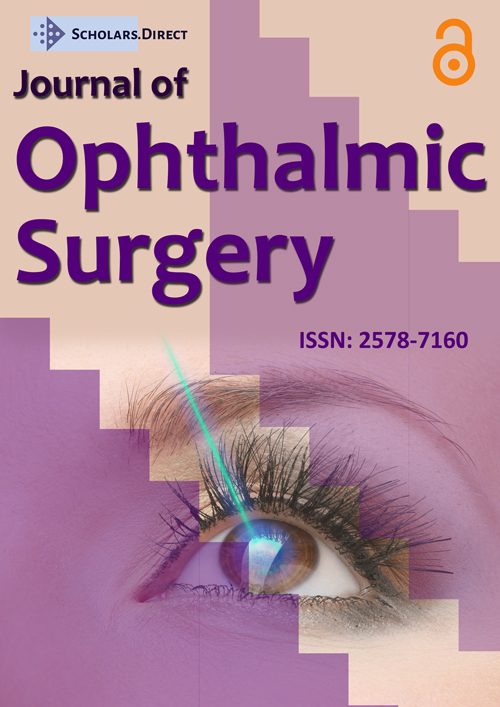Capsular Bag Irrigation to Decrease the Tendency of the Iris. A Technique for Bimanual Irrigation and Aspiration
Dear Editor,
We would like to introduce a simple technique for the bimanual irrigation and aspiration (I/A) of ophthalmic viscosurgical device (OVD) and cortical material during cataract surgery.
Iris prolapse occurs when the forces pulling on the iris toward the wound exceed the ability of the iris' tone to maintain the position of the iris in the anterior chamber [1].
Anterior wound placement should help to prevent iris prolapse. Minimizing the irrigation velocity, and hence the fluid outflow velocity should also help to prevent intraoperative prolapse [2].
Many surgeons prefer not to place the irrigation/aspiration (I/A) tip behind the optic during removal of an ophthalmic viscosurgical device (OVD) for fear of inducing a posterior capsule rupture [3].
We had been using irrigation tip to push IOL optic sideways and irrigate retrolenticular space to ease removal of OVD via aspirating cannula. We have observed that the intracapsular irrigation maintained the intraoperative position of the iris with adequate formation of the capsular bag and anterior chamber even during removal of the OVD from the anterior chamber. Then we have decided to use capsular bag irrigation during cortex removal as well. Iris prolapse was seen to occur less frequently.
After phacoemulsification is completed, the irrigation cannula is directed into the capsular bag to achive irrigation in the capsular bag. In our technique irrigation tip is introduced into the capsular bag without a stop in the anterior chamber while the aspiration tip is held just in the tunnel of the other side port occluding it and preventing egress of fluid from the anterior chamber.
While traversing the anterior chamber, the inflow is observed to cause some flutter of the iris and a slight forward movement of the iris, but after positioning the irrigation tip in the capsular bag the iris is seen to move backward and stop fluttering. Being placed in the capsular bag and the direction of egressing fluid towards the lens equator, the irrigation cannula provides excellent iris stability and positioning, and it also keeps the anterior chamber and capsular bag well distended for easy removal of cortex via the aspiration tip inserted through the other side port.
After complete cortical cleanup is accomplished, OVD is used to fill the anterior chamber and the capsular bag. IOL is implanted as usual. Then the irrigaiton tip is placed in the capsular bag below the level of anterior capsule while the anterior chamber is still filled with the OVD and before the IOL has been centered. The aspiration port is placed in the capsular bag facing the cornea, and is positioned behind the IOL optic with the IOL still slightly decentered.
Then the OVD is removed from the anterior chamber while the irrigation tip is still kept in the capsular bag.
By using this technique we should have reduced the velocity of fluid flowing in the anterior chamber. By directing irrigation flow into the capsular bag we should have the chance for better endothelial protection otherwise irrigation solution turbulence in the anterior chamber could cause more endothelial damage [4].
We found this technique to be safe and effective in reducing the frequency of iris prolapse during bimanual I/A. The other advantages are increased anterior chamber depth, pupillary dilation maintenance during I/A, and well-distended capsular bag helping in the avoidance of accidental posterior capsule capture and rent.
References
- Chan DG, Francis IC (2005) Intraoperative management of iris prolapse using iris hooks. J Cataract Refract Surg 31: 1694-1696.
- Allan BD (1995) Mechanism of iris prolapse: A qualitative analysis and implications for surgical technique. J Cataract Refract Surg 21: 182-186.
- Tak H (2010) Hydroimplantation: Foldable intraocular lens implantation without an ophthalmic viscosurgical device. J Cataract Refract Surg 36: 377-379.
- Mencucci R, Ponchietti C, Virgili G, et al. (2006) Corneal endothelial damage after cataract surgery: Microincision versus standard technique. J Cataract Refract Surg 32: 1351-1354.
Corresponding Author
Ahmet Colakoglu, MD, School of Medicine, Ophthalmology Department, Acibadem Mehmet Aydinlar University, Zubeyde Hanim Cad, Blok: F26, Daire: 4, Atakoy 1. Kisim Mah, Bakirkoy 34158, Istanbul, Turkey
Copyright
© 2021 Colakoglu A, et al. This is an open-access article distributed under the terms of the Creative Commons Attribution License, which permits unrestricted use, distribution, and reproduction in any medium, provided the original author and source are credited.




